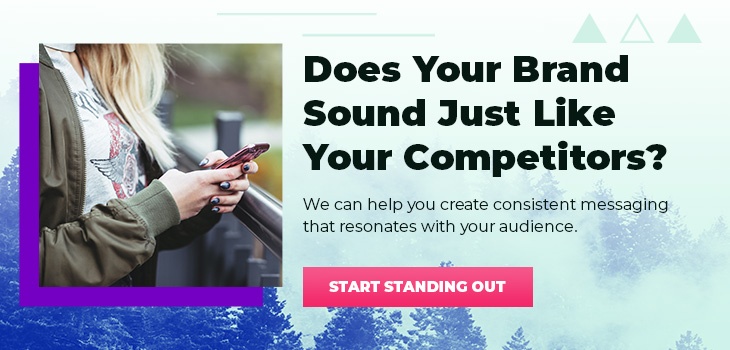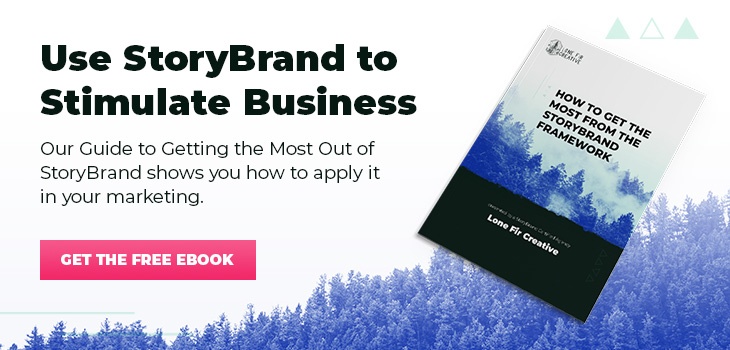You’ve heard about messaging. You’ve probably seen it on LinkedIn, discussed it in meetings, maybe even attended a webinar or two. It’s not a secret that messaging is a foundational element of any successful business.
That’s why working within a messaging framework is so important — it keeps you focused on the most important aspects of your brand message so you create something clear, concise and compelling.
However, many businesses aren’t sure what goes into a messaging framework, what their options are or how to apply it to their marketing strategy. That’s what we’re here to tackle today.
We’ll kick things off with a brief explanation of what a messaging framework is, then dive into why it’s important and its different parts so you can see exactly how the framework applies to your business.
What Is a Messaging Framework?
A messaging framework is a strategic outline of how you’ll communicate your brand promise to customers and prospects. It helps you develop your messaging strategy, which will guide communications across all marketing, sales and service channels in your business.
Your messaging framework is to copy and content what a website blueprint is to your web design. It simply provides a structure for you to work within as you develop your brand voice and tone and decide how to communicate value to customers.
How It Helps Your Brand
Now onto the more important question: How does a messaging framework help your brand? At the end of the day, most of marketing comes down to conversions. But to get these conversions, your copy has to resonate with your target audience. From web copy to emails to sales outreach, you want to ensure you’re speaking your customer’s language.
That’s where messaging comes in.
A messaging framework encourages you to define clear, concise language for your brand so you have guiding principles for what will most impact your audience.
At Lone Fir, we use the StoryBrand Framework, which focuses on making the customer the hero and speaking directly to their problems. This helps you demonstrate that you understand their pain and frustration, are qualified to offer a solution and have one that will improve their lives.
Although messaging is necessary in every industry, it’s especially critical in technical or complex industries. If you have a product or service that’s difficult for your audience to understand right away, it’s imperative that you spend time working through a messaging framework to ensure you’re communicating effectively with buyers. A few of these industries include:
- SaaS products
- Tech industries (EdTech, MedTech, FinTech)
- Financial services
Breaking down complex topics into language your ideal customer can understand removes significant barriers in their buying process. Because the truth is, people won’t take the time to learn what you do. They want to know now and if they can’t figure it out, they’ll go somewhere else.
A messaging framework forces you to narrow your thinking to your audience’s core problem and explain your solution in plain terms. This shows the buyer that you understand how they feel and builds trust among your audience.
Parts of a Great Messaging Framework
There are a lot of different frameworks out there that you can use to clearly define your brand messaging. As we mentioned, our favorite is StoryBrand, so we’ll use that as our example for this blog.
The StoryBrand Framework addresses seven basic elements of your messaging:
#1 Your Audience
The very first step is to know who you’re talking to. But you have to go beyond just the demographic information in your buyer personas. To understand how to speak to your ideal audience, you need to understand their psychographics — the thoughts and feelings that drive them to seek out and ultimately purchase your product or service.
One pitfall many businesses fall into in this step is wanting to outline every pain point their target customers have. Although this might seem like the best approach, it’s more akin to painting a fence post with a roller brush. Broad strokes don’t work on a narrow surface.
It’s more important to hone in on your customers’ primary problem so that you can clearly communicate a single solution. This reduces confusion about your brand and helps you to greatly resonate with a single issue, creating more effective messaging.
This is often the toughest part of nailing down your messaging strategy, but it’s imperative for success. Take your time to really think through your audience’s point of view and try to see your brand from their perspective.
#2 Your Brand
Next, you need to define who you are. This can be derived from your company vision, mission statement, brand personality or other foundational elements you created when developing your branding. The goal here is to identify how to communicate key messages in a way that aligns with your brand identity.
Think about how you want to position yourself in the market and how you want customers to perceive your brand. What language will achieve these two goals? What messages do customers need to hear to be convinced this is who you are?
For example, imagine an EdTech company sells a product that translates textbooks to Braille for blind students. They might position their brand as follows: “We believe in education equity. Our tools enable vision-impaired students to be part of the classroom community and fully participate in the joy of learning with others.”
This statement clearly communicates the mission of their company and positions them as a classroom partner who can help students succeed despite a disability.
#3 Your Solution
Now that you have a firm idea of who you’re speaking to and how to position yourself, you have to show why you’re worth your customer’s time. This is the art of communicating your solution: How will you solve your customer’s problem and improve their life?
The words you choose to explain your solution are critical to creating trust and buy-in among your audience. You need to speak their language and use terms that resonate with them. Take a problem-solution approach and make it exceptionally clear how your solution will make their lives better or easier.
Let’s go back to the EdTech example from the previous section. Their marketing message paints a clear picture of not only what the solution is but also how it improves the user’s life: “Our tools enable vision-impaired students to be part of the classroom community and fully participate in the joy of learning with others.”
You can envision what this solution looks like. A student reading a textbook aloud to his class with the help of this Braille tool. It’s a means to overcome educational barriers and help disabled children more easily integrate with their peers. Plus, it makes the teacher’s life easier because she doesn’t have to adapt portions of the lesson for a single student.
#4 Value Proposition
In this section of the messaging framework, you’re demonstrating the value of working with you. Remember, StoryBrand isn’t a values-based approach, it’s a problem-solution approach. So your value proposition should still be centered around the primary problem you solve.
It’s important to go beyond superficial brand value in this step. You want to consider your differentiators and key selling points, then align them with your core message. This will help you focus on how you’re solving the problem and show your audience the different ways you can improve their lives.
It’s natural for your marketing team to want to really promote this part of your messaging strategy, however, it often works best in a supporting role. Your marketing campaigns should focus on building a relationship with potential customers. These value points are used more to reinforce that you’re a good choice than to really sell them on the idea of your brand — that’s your solution’s job.
#5 How to Work With You
Also called the “process plan,” this section of your messaging strategy clearly outlines what people need to do to purchase from you. It’s typically a three-step plan that outlines the purchase process in plain terms so people know what to expect from you and what will be needed of them.
This is another area where businesses are often challenged. After all, taking people from the starting point in their journey all the way to purchase in just three steps is a big ask, especially if you have a complicated process.
The goal is to refine your process into big-picture steps that are easy for potential customers to understand and make it easy to get on board. Plus, working through communicating your process is often a helpful way for you to determine if you’ve made it too difficult or confusing for your customers.
Let’s use our EdTech example company one more time to see what a process plan might look like. Their website could instruct viewers to:
- Schedule a discovery call with our sales team.
- Review our product types.
- Choose the package that best fits your needs.
The website would include some subtext to give a brief explanation to each of these points, but you get the picture. These are three clear steps that give people an idea of what the sales process looks like. This will help reduce anxiety, prepare them for next steps and build some trust that they’ll come out with the option that’s best for their students.
#6 Call to Action
You’ve set up all the dominoes for your brand messaging strategy in these steps of the framework. Now it’s time to knock them down. And by that, I mean ask for the sale.
Your call to action might seem like a simple part of the framework template, but it’s one of the most important aspects. Don’t write it off or breeze through it just because it’s only a few words long.
Your call-to-action should be clear, concise, and, above all, actionable. It needs to be a phrase that catches people’s eye and encourages them to click the button and take the next step.
Things like “Buy now” and “Learn more” are overused these days, so you need to think outside of the box. Instead, use phrases that are unique to your business and solution. The EdTech company example could use “Empower Students” or “Equalize Education” as their CTA. That not only encompasses their brand positioning statement and mission, it also makes users feel like pressing that button will really make a difference in their lives and the lives of their students.
#7 One-Liner
This section is unique to StoryBrand but it’s one of the primary reasons I love the framework. Your one-liner is essentially your elevator pitch: Who you are in two sentences or less. It’s informed by all of the information you’ve gathered and outlined in your messaging strategy. It’s a quick overview of what you do and why it’s beneficial to your customers.
You should use your one-liner on your website, but that’s not its only purpose. These two sentences should serve as the foundation of all content creation. Every piece of content, line of web copy and customer service interaction should reflect this simple idea and communicate it to your audience. That’s what creates consistency throughout your brand and the customer experience.
Send the Right Message
And that’s it — the messaging pillars that make up almost every brand messaging framework. This process will help you prioritize impactful aspects of messaging, like tone of voice and positioning, and align your sales, marketing and service teams in everything they do.
We know that following a messaging framework and developing a comprehensive strategy is hard work and requires dedicated time. That’s why we help brands craft custom BrandScripts. We offer messaging workshops to nail down your strategy when you’re just getting started or before making big shifts in your marketing efforts.
Get in touch with us to learn more about how we can help!





